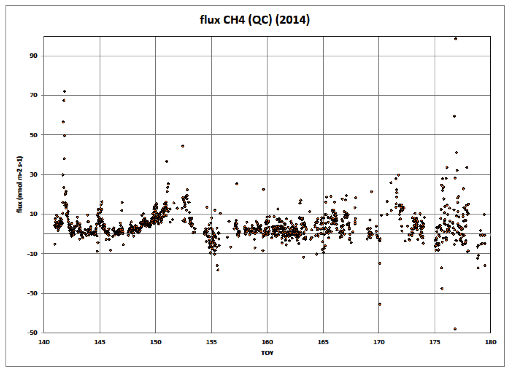AmeriFlux and Methane Evaluation VAP Now Available for Barrow Data
Published: 21 April 2015

The ARM Climate Research Facility installed a suite of instruments—Eddy Correlation Flux Measurement System (ECOR), Surface Energy Balance System, and an AmeriFlux Measurement Component (AMC)—near the North Slope of Alaska (NSA) Barrow site to measure the fluxes of carbon dioxide and methane, the most common GHGs, from the Arctic coastal tundra. Similar to the ECOR systems installed at the Southern Great Plains site, these instruments also include a fast-response sensor for atmospheric methane densities. Rather than disrupt the unified processing of the ECOR systems, the observations from this sensor are being incorporated into an evaluation value-added product (VAP) called the NSA-Barrow AmeriFlux and Methane VAP.
This data product uses datastreams from all three instrument systems (ECOR, SEBS, and AMC) to produce a data set focused on GHG fluxes. While much of this VAP may seem redundant to the ECOR datastream, the post-processing is different and incorporates several nuances and corrections that are not in the usual ECOR product. In addition, by combining data from these three instrument systems, users will find all of the relevant ARM observations for GHG studies in one place.
The fluxes reported in this VAP have all been fully corrected and represent a “best practices” estimate to the release of GHGs in this area. The data post-processing protocols and codes have all been validated against AmeriFlux standards, and the data set presented here contains not only the GHG and energy fluxes, but other variables that represent process controls and climatic drivers of the fluxes. Potential users who are familiar with AmeriFlux data sets will see many similarities between this product and those contained in the AmeriFlux data archive.
Feedback and use of the data are welcomed and encouraged; for questions or to report data problems, please contact Dave Billesbach. To access this data set, browse the ARM Data Archive. (Request an account here to download the data.)
# # #
The ARM Climate Research Facility is a national scientific user facility funded through the U.S. Department of Energy’s Office of Science. The ARM Facility is operated by nine Department of Energy national laboratories.
The ARM Climate Research Facility is a DOE Office of Science user facility. The ARM Facility is operated by nine DOE national laboratories, including .
Keep up with the Atmospheric Observer
Updates on ARM news, events, and opportunities delivered to your inbox
ARM User Profile
ARM welcomes users from all institutions and nations. A free ARM user account is needed to access ARM data.


















